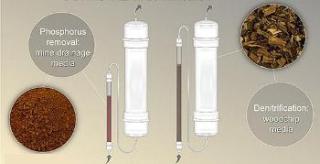Aug 1 2017
Algae blooms in the Gulf of Mexico use most of the oxygen in the water which results in massive "dead zones" that are incapable of supporting fish or other wildlife. Nitrate, running off agricultural fields via tile drainage systems, is one of the reasons for this situation.
However, nitrate is only part of the problem. Algae in ponds and freshwater lakes flourish when exposed to a different pollutant, phosphorus, and the smallest amount is sufficient for a bloom to get triggered.
 This image shows the experimental setup of the lab-scale bioreactor and P-filter. Credit: Laura Christianson
This image shows the experimental setup of the lab-scale bioreactor and P-filter. Credit: Laura Christianson
In order to reduce the phosphorous and nitrate pollution in the Gulf of Mexico, Illinois and the 11 other states that send most of the water to the Mississippi River have set aggressive goals. To accomplish those goals, large point sources of phosphorus, such as wastewater treatment plants, will have to invest in new infrastructure. However, new research suggests that Farmers could possibly play a role too.
Laura Christianson, Assistant Professor of Water Quality in the Department of Crop Sciences at the University of Illinois, is a skilled professional in the domain of woodchip bioreactors. She has done widespread work to show the potential of the woodchip-filled trenches in eliminating nitrate from tile drainage water in Illinois croplands.
The woodchips and the nitrate are necessary for the bacteria to complete their life cycles. As they consume the nitrate, it is removed from the water. It's a biological process.
Laura Christianson, Assistant Professor of Water Quality in the Department of Crop Sciences, the University of Illinois
In a recent study, Christianson and several colleagues thought about removing phosphorus by adding a special "P-filter" exclusively developed to trap the fertilizer-derived pollutant. The team tested two kinds of industrial waste products in the P-filters: steel slag and acid mine drainage treatment residual (MDR). Phosphorous adheres to elements such as aluminum, calcium and iron contained in these products, removing it from the water.
Instead of mixing steel slag or MDR with woodchips in one large phosphorus and nitrate removing machine, the team placed a separate P-filter downstream or upstream of a lab-scale bioreactor. They ran wastewater from an aquaculture tank through the system and measured the amount of nitrate and phosphorus at several points along the way.
Regardless of P-filter type and whether the P-filter was downstream or upstream of the bioreactor, nitrate removal was consistent. However, MDR was far better as a phosphorus filter. "It removed 80 to 90 percent of the phosphorus at our medium flow rate," Christianson says. "That was really, really good. Amazing."
On the other hand, only about 25% of the phosphorus was removed by the Steel slag.
But steel slag is a lot easier to find in the Midwest. And according to the Illinois Nutrient Loss Reduction Strategy, we're only trying to remove 45 percent of the phosphorus we send downstream. Since agriculture is only responsible for half of that, 25 percent would be pretty good.
Laura Christianson, Assistant Professor of Water Quality in the Department of Crop Sciences, the University of Illinois
Although, the system clearly shows potential, several unknowns still remain. Paired P-filters and bioreactors are yet to be tested in real-world conditions; in spite of a handful being already installed in the United States. Probably more significantly, Researchers don't have a good handle on how much phosphorus is running off agricultural fields in tile drainage.
We suspect our tile drainage in Illinois doesn't have much phosphorus in it, but we know there is some. We're getting a better handle right now on just how much phosphorus we have. We know that phosphorus moves more readily in surface runoff. When you have soil eroding and the water is murky and brown, there's generally phosphorus attached to the soil. The easy way to sum it up is if you have tile drainage, you should be more concerned about losing nitrate in that water, but if you have hillier land, you should be more concerned about soil erosion and losing phosphorus.
Laura Christianson, Assistant Professor of Water Quality in the Department of Crop Sciences, the University of Illinois